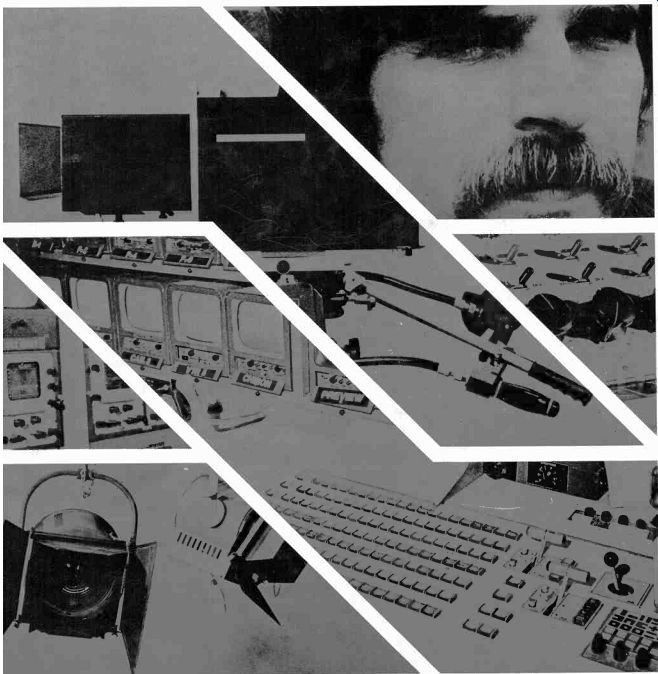
Contents
1. Learning Television Production
2. The Camera
3. Lenses
4. Mounting Equipment and Camera Operations
5. Lighting
6. Techniques of Television Lighting
7. Audio
8. The Television Studio and Control Centers
11. Special Effects
12. Design
14. Producing
15. Directing
(18). Additional Reading
(19). Glossary

Intro / Preface
The third edition of Television Production Guide [ca. 1976] is not a simple revision of the second edition; it is a new guide [ca. 1976]. The dramatic new developments in television equipment and subsequent production techniques have made such a step necessary.
Bringing the earlier edition up to date called for thorough reorganization. In order to incorporate the new developments of production equipment and techniques, and the changes they triggered on each other, I have not only revamped the original sections but added several new ones.
Subjects that seemed to require an entire new section included: the machinery and the principles of postproduction; the production process and the possible application of a production systems design; directing; and small-format television operation, usually called "video." Scenery, properties, and graphics are now combined in a single section on design. The section on television talent covers not only the elementary performance and acting techniques but, briefly, the basic makeup and dress requirements as well.
Basically, this guide discusses the major tools of present-day color television production and their use under normal circumstances. However, since black-and-white television is still widely used in broadcast education, I have retained discussion of some of the prominent monochrome equipment and its operation.
Three special features of this text are designed to help the reader cope with a large amount of detailed information without being overwhelmed by it. First, major emphasis is put on equipment categories and production principles rather than on specific name brands or equipment codes as used by the various manufacturers. Thus, a minor change of name or equipment number by a particular manufacturer will not render the information contained in this guide invalid. I have, nevertheless, provided tables and illustrations that contain brand names and equipment numbers, so that certain equipment items currently used can be clearly identified by production and engineering personnel. Second, the key terms used in a given section are collated and defined at the beginning of that section. This device offers the reader the opportunity to preview the new terminology, to see the words again in the context of the actual equipment or production situation as discussed in the section, and then to reinforce his or her learning by checking the meanings once again in the glossary. Third, some of the important, yet peripheral, aspects of television equipment and production techniques appear as information in reduced type, usually in the outside columns.
I have used photographs rather than drawings whenever appropriate in order to reduce the jump from print to the real thing.
Fortunately, even the most sophisticated machine cannot replace human judgment entirely in television production. Therefore, in this edition, I give attention to some of the basic aesthetic principles, such as picture composition, picture continuity, and sound mixing. I enjoin the reader to realize that the dos and don'ts of television production techniques as expressed in this guide are intended as a guide, not as a credo. And, after all, I understand that we need to learn the conventional approach before we can go beyond it, or abandon it with some degree of authority.
Many more people and organizations deserve much credit for assisting me with specific information or materials, among them: ABC; Akai America, Ltd.; Ampex Corporation; Angenieux Corporation, Los Angeles; Audio Designs and Manufacturing, Inc.; Berkey Colortran, Inc.; Broadcast Communication Arts, BCA 595(2), Fall Semester 75/76; CBS; CMX Systems; Commercial Electronics, Inc.; Ed Cosci, KTVU; Cunningham and Walsh, Inc., Los Angeles; Electro-Voice, Inc.; Gotham Audio Corporation; Grass Valley Group, Inc.; Ray Holtz, Group W Station KPIX; International Video Corporation; Keep America Beautiful, Inc.; KGO; Marshall King, CBS; Kliegl Bros.; KRON; KTVU; Hal McIntyre, KPIX; Mole-Richardson Co.; NBC; Dick Newmann, RCA; Bill Noethens, KNXT; Orrox Co.; Philips Audio Video Corp.; Jim Provence, San Francisco State University; Q-TV of Q-Co Industries; RCA; Michael Sales, San Francisco State University; Frederick J. Schuhmann, ABC New York; Sennheiser Electronic Corporation; Shure Brothers, Inc.; Walt Stewart, KPIX; Swintek; Robert Tat, Fireman's Fund; Vega Electronics Corporation; Vital Industries, Inc.; Ken Wilson, KGO; Howard Yuen, KPIX; Ian Zellick, KTVU. I also extend a special word of thanks to Ben Duban for his excellent prints of many of the photographs.
Many thanks to my wife, and to my children, who not only tolerate my writing but make sure that I do the best work I can.
This guide is based on:
Television Production Handbook, Third Edition
by Herbert Zettl, San Francisco State University
Wadsworth Publishing Company, Inc., Belmont, California
© 1976 by Wadsworth Publishing Company, Inc.
Communications Editor: Rebecca Hayden Designer: Gary Head Production Editor: Rebecca Hayden Illustrator: Steve Renick
ISBN 0-534-00414-8 L. C. Cat. Card No. 75-35421, Printed in the United States of America
Also see:
Television -- Critical Methods and Applications
Air Time--An Intro to Television Broadcasting